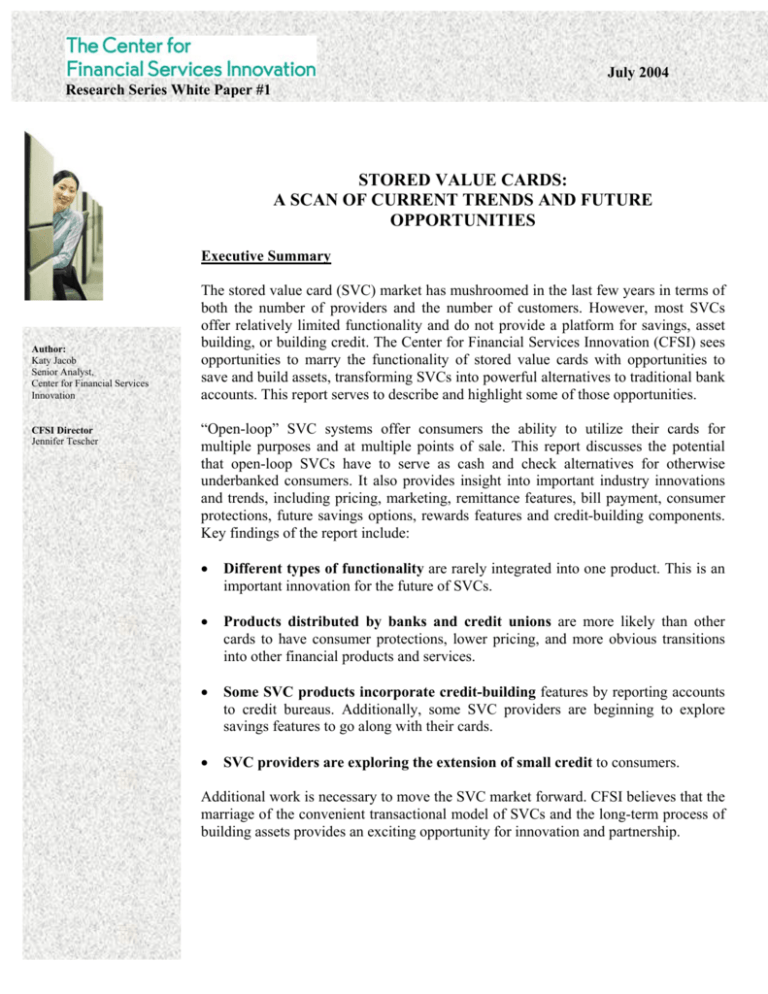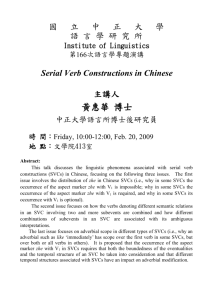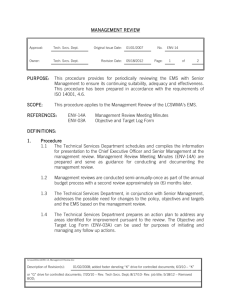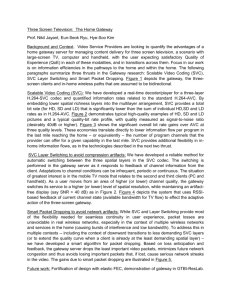Stored Value Cards: A Scan of Current Trends and Future
advertisement

July 2004 Research Series White Paper #1 STORED VALUE CARDS: A SCAN OF CURRENT TRENDS AND FUTURE OPPORTUNITIES Executive Summary Author: Katy Jacob Senior Analyst, Center for Financial Services Innovation CFSI Director Jennifer Tescher The stored value card (SVC) market has mushroomed in the last few years in terms of both the number of providers and the number of customers. However, most SVCs offer relatively limited functionality and do not provide a platform for savings, asset building, or building credit. The Center for Financial Services Innovation (CFSI) sees opportunities to marry the functionality of stored value cards with opportunities to save and build assets, transforming SVCs into powerful alternatives to traditional bank accounts. This report serves to describe and highlight some of those opportunities. “Open-loop” SVC systems offer consumers the ability to utilize their cards for multiple purposes and at multiple points of sale. This report discusses the potential that open-loop SVCs have to serve as cash and check alternatives for otherwise underbanked consumers. It also provides insight into important industry innovations and trends, including pricing, marketing, remittance features, bill payment, consumer protections, future savings options, rewards features and credit-building components. Key findings of the report include: • Different types of functionality are rarely integrated into one product. This is an important innovation for the future of SVCs. • Products distributed by banks and credit unions are more likely than other cards to have consumer protections, lower pricing, and more obvious transitions into other financial products and services. • Some SVC products incorporate credit-building features by reporting accounts to credit bureaus. Additionally, some SVC providers are beginning to explore savings features to go along with their cards. • SVC providers are exploring the extension of small credit to consumers. Additional work is necessary to move the SVC market forward. CFSI believes that the marriage of the convenient transactional model of SVCs and the long-term process of building assets provides an exciting opportunity for innovation and partnership. Introduction In the wake of dramatic technological advancements over the last decade, the financial services industry has developed a number of inventive applications that have the potential to improve the structure and delivery of retail products for unbanked consumers. One of the most innovative is the stored value card (SVC), a prepaid debit card that mimics a checking account, but without checks. They offer consumers who cannot qualify for or do not want a traditional bank account a safe and efficient way to store funds, make purchases, pay bills – and possibly save and build credit. The most common application of SVCs is the payroll card, which enables employers to pay their unbanked workers via direct deposit. At least 10 million American households—disproportionately poor, minority, lower income and young—are unbanked. Additional households conduct most of their financial transactions outside of banks even though they may have a savings or checking account. Yet having a relationship with the financial services system can minimize the cost of financial transactions and help turn income into savings, assets and wealth. SVCs could be a valuable financial tool for these consumers for several reasons: • SVCs generally lack the identification and credit requirements that effectively bar millions of individuals from opening traditional bank accounts. • SVCs can be purchased and reloaded at a growing number of locations other than bank branches, such as check cashers and other retailers. • SVCs can provide immediate availability of funds at a cost that is, in some cases, lower than some other alternatives for unbanked consumers. • SVCs are prepaid and thus nearly impossible to overdraft, reducing the likelihood of unexpected fees. The SVC market has mushroomed in the last few years in terms of both the number of providers and the number of customers. However, most SVCs offer relatively limited functionality and do not provide a platform for savings, asset building, or building credit. The Center for Financial Services Innovation (CFSI) sees an opportunity to marry the functionality of stored value cards with opportunities to save and build assets, transforming SVCs into powerful alternatives to traditional bank accounts. This report serves to describe and highlight some of those opportunities. The report has three main components. First, it gives a brief overview of SVCs, the size of the market, and how they work. Second, the report serves as an informal survey of stored value card products currently being offered. Third, it discusses ways in which SVCs could be used to help consumers build assets and describes specific product offerings that have taken a first step in that direction. 2 2230 S. Michigan Avenue, Suite 200 Chicago, IL 60616 312-881-5856 / 312-881-5801 www.cfsinnovation.com What are SVCs and How Do They Work? Overview of Card Structure Like traditional debit cards, stored value cards utilize magnetic stripe technology to store information and track funds. However, SVCs differ from account-based debit cards by being prepaid, which limits the risk of overdrafts while providing nearly immediate liquidity for consumers. Early uses of SVCs in the United States included public transportation, public assistance payments, and child support payments. Many unbanked consumers have been using SVCs to access public benefits for years. For instance, in Illinois, welfare recipients have been receiving their benefits electronically since 1996. Moreover, in 1996, the Debt Collection Improvement Act (DCIA) was passed to require the use of electronic funds transfer (EFT) for most Federal payments, with the exception of tax refunds, starting January 2, 1999.1 SVCs today take several forms, including gift and phone cards, payroll cards, and prepaid debit cards. SVCs are an increasingly popular instrument for one-time uses such as life insurance payments and moving expenses. SVC systems operate in two ways. One is the “closed-loop” system, which can be used only for the issuer’s products or for limited purposes, such as prepaid gift cards through retailers like Old Navy or many prepaid phone cards. “Open-loop” systems offer consumers the ability to utilize their cards for multiple purposes and at multiple points of sale, such as making purchases at a variety of stores or paying bills. “Branded” cards have a MasterCard or Visa logo and utilize signature-based technology to allow the consumer to transact business anywhere that those brands are accepted, as well as through ATM and point of sale (POS) machines. “Non-branded cards” use PIN-based technology and enable transactions only through POS or ATM networks. Non-branded cards require the use of a PIN; signature-based transactions are not available. Stored value cards use accounts to manage funds in real time through host computer systems. The accounts are held in a single concentrator account with different subaccounts for each card. Depending on how the issuing financial institution treats the accounts (some are “pooled” accounts and some, for accounting purposes, are actual bank accounts held by the individual consumer), SVCs may or may not carry FDIC insurance. The issue of FDIC insurance for SVCs is a point of some controversy, and it will be discussed in greater detail below. This report will cover examples of open-loop SVCs, which come closest to resembling traditional bank accounts. Consumers can make deposits onto the cards and withdraw cash or pay bills at a later date; in some cases, they can have funds directly debited on a recurring basis. Open-loop SVCs can be grouped into three categories: payroll-only cards, which can be used only for direct deposit of paychecks or, in some cases, other automated clearinghouse (ACH) deposits, such as Social Security Payments; reloadable payroll cards, which serve primarily as direct deposit cards for payroll checks but offer consumers other ways to reload the cards; and reloadable debit cards, which consumers can reload in a variety of ways at a range of locations. 3 2230 S. Michigan Avenue, Suite 200 Chicago, IL 60616 312-881-5856 / 312-881-5801 www.cfsinnovation.com For the most part, these products are offered in a “silo” style. In other words, SVCs do not currently function in a way that allows a single card to function across channels. Major players in the industry, such as MasterCard, currently segregate SVCs into different lines of business. For example, they consider “consumer-funded” (reloadable prepaid cards) and “business-toemployee” (payroll cards) as different products. The functionality of different types of SVCs is rarely integrated into one product. This is an important innovation for SVCs to become true substitutes for bank accounts and broadly accepted by consumers. Description of Important Actors The SVC market includes hundreds of product providers, with new ones emerging frequently. Given the various functions involved in offering SVCs—card issuance, transaction processing, funds management, customer service, recordkeeping—sorting out roles and responsibilities can be complicated. For instance, several banks have their own SVC programs in which they use third-party transaction processors, but many of them also serve as issuers for other non-bank SVC programs, which may use different transaction processors. A few SVC providers are vertically integrated, handling nearly all of the functions internally, while others outsource everything except sales and marketing. The majority of SVC providers outsource the transaction processing to one of the many firms that have developed special software platforms for running SVCs. While numerous companies are now engaged in the provision of SVCs, some firms stand out. Major players in the market today include: • • • • • Bank providers/issuers: BANKFIRST, Bank of America, Citibank, and JP Morgan Chase Providers of reloadable prepaid debit cards: NetSpend and Next Estate SVC processors: Metavante, StarSystems, WildCard and Galileo Providers of back-end services for SVCs, including ATM and POS processing,: Pulse* Payroll firms: Paychex and Comdata An increasing number of companies are attempting to compete in this market space. It is entirely possible that, over time, those prominent today may be displaced in the future by new entrants. Moreover, other relative unknowns are likely to emerge as the market sorts itself into better defined mass-market and niche product markets. The distinction between products that are distributed by financial institutions and those distributed by non-bank firms is an important one. Products distributed by banks and credit unions are more likely to have additional consumer protections, lower pricing (because fewer actors are involved), and more obvious transitions into other financial products and services. These issues will be discussed in further detail below. * Pulse also offers its own SVC product. 4 2230 S. Michigan Avenue, Suite 200 Chicago, IL 60616 312-881-5856 / 312-881-5801 www.cfsinnovation.com Legal and Regulatory Concerns As a new product with few comparables, SVCs raise several complex legal and regulatory concerns. The issue of whether SVCs are considered depository accounts is a timely one that is currently under review by the Federal Deposit Insurance Corporation (FDIC). If funds stored on SVCs are considered deposits, FDIC insurance could then apply. If a financial institution pools the SVC accounts and does not provide individual “sub-accounts” to cardholders, FDIC insurance is not available on an individual customer basis. But if a financial institution offers the SVC as an individual bank account-like product, “pass-through” FDIC insurance might apply. A scan of the SVC universe finds that payroll cards appear to be more likely to offer FDIC insurance than reloadable debit cards. Banks that issue SVCs can voluntarily provide disclosures to that describe consumer protections.2 The Office of the Comptroller of the Currency (OCC), the bank regulator for national banks, has recently issued guidance to its member banks on proper disclosures of consumer protections for SVCs.3 But, ultimately, it is still unclear whether SVCs are subject to Regulation E, which covers all electronic financial transactions and requires that a record be provided for each transaction. Consumer advocates argue that if consumers are going to use SVCs as substitutes for bank accounts, then the cards should carry the same protections, and Reg E should therefore apply. Some SVC providers welcome the expansion of FDIC insurance to SVCs and are already operating as if their products are considered deposits. On the other hand, some industry representatives argue that SVCs should not be compared to bank accounts—that they are in fact more aptly compared to cash, and for that reason Reg E is not appropriate. They worry that, if funds placed on these cards are in fact considered deposits by federal regulators, additional costly infrastructure and regulatory oversight might be required. This could change the current economic model for SVCs and make them a less attractive business opportunity. Moreover, as concerns around terrorism and money laundering mounted following September 11, 2001, financial institutions came under pressure to keep and report accurate records proving their customers’ identities. Section 326 of the USA PATRIOT Act requires financial institutions to be more diligent in documenting customer identification, which has had significant impact on enrollment processes and management of SVC programs. Most SVC providers do not currently require that customers provide Social Security Numbers if their cards are PIN-based. Considering that some underbanked consumers cite privacy as a primary concern, the reduced identification requirements for PIN-based SVCs may help encourage customer acceptance.† At the same time, Visa and MasterCard require Social Security Numbers for signature-based SVCs, an important change in the industry following the PATRIOT Act. Another emerging issue around the PATRIOT Act is that some SVC products allow consumers to give second cards to † ITIN stands for Individual Taxpayer Identification Number. It is a number that the IRS provides to workers who do not have Social Security Numbers in order to enable them to pay federal and state income taxes. Many financial institutions have begun accepting ITINs in order to open bank accounts. Though many immigrants do not have Social Security Numbers, the PATRIOT Act allows for the acceptance of ITINs in their place. 5 2230 S. Michigan Avenue, Suite 200 Chicago, IL 60616 312-881-5856 / 312-881-5801 www.cfsinnovation.com family members in other countries as a way to transfer money, and it can be difficult to verify the identity of individuals living outside the U.S. Another important legal issue is specific to payroll cards and underscores the importance of consumer protections for these cards. Many states mandate that an employer cannot demand that workers receive their pay in a specific manner; payroll cards must be offered as an option rather than a requirement.4 In other words, consumers in some states have their choice in payment systems protected—they cannot be required to accept a payroll card if they do not have a bank account. State laws differ greatly on this issue, yet many payroll card products are structured to be offered nationwide. Size of the Market The SVC market has exploded in recent years, with the number of cards and providers in the market growing at a breakneck pace. MasterCard claims to have more than 200 SVC programs of different types with 100 issuers, and the company has seen double-digit increases in relationships with third parties and SVC processors in the last few years.5 One research firm relates that in the early years of SVC usage, transaction volumes grew 350% between 1993 and 1997, from $600 million to $3 billion.6 Though this volume was low in comparison to that for other types of cards, it represented the largest increase in usage of any type of plastic payment at the time, with a 50% increase in volume every year.7 As a point of comparison, during this same time period, debit card volume increased by over 40% and overall plastic payment volume doubled.8 It is difficult to ascertain the current size of the SVC market in a way that segregates closed-loop and open-loop processes. Industry estimates—projected by some to be over $2 trillion—tend to combine gift card volume with more functional transaction-oriented SVCs and are difficult to verify. Estimates of the size of the payroll card market abound. According to one study, the number of payroll cards in circulation doubled between 2002 and 2003 to over 2.2 million cards.9 A spokesman for a major provider of stored value payroll cards estimates that about two million U.S. employees currently use the cards. Celent Communications reports that 10% of unbanked American workers used payroll cards in 2002, and the company estimates that the portion of unbanked families using these cards could rise to 25% by 2006.10 Another research firm, Financial Insights, forecasts that payroll cards will be worth $143 billion in transactions by 2007.11 Yet another industry expert estimates that payroll cards have the potential to serve 150 million consumers in the US.12 These figures may mask the loss of revenue from dormant cards and the high dropout rate of SVC users who, in some cases, stop using the card soon after receiving it. Reasons for this trend are unclear. Two possibilities are that some consumers find they prefer to deal with cash and that others incur too many fees to make the cards reasonable for them. As consumers stop using their cards, SVC providers stop receiving fee and transaction revenue but continue to incur expenses associated with keeping the cards on the system. 6 2230 S. Michigan Avenue, Suite 200 Chicago, IL 60616 312-881-5856 / 312-881-5801 www.cfsinnovation.com It is important to note that use of payroll cards extends beyond the unbanked. Analysts estimate that the number of payroll card users could rise to almost 7 million by 2006, with as many as 10% of these households holding bank accounts in addition to the payroll cards.13 Moreover, employers are becoming creative with moments of opportunity for distribution. For example, UHaul, which pays about 17% of its 17,000 employees through Bank of America’s CashPay program, offers the card as a company benefit and recruitment tool.14 Another factor in estimating the size of the SVC market is employee turnover. As employees switch jobs, large percentages of SVC users drop out of the market because most SVCs are not designed to be truly portable. An accurate analysis of the size of the SVC market should combine both the number of active cards in the market and transaction volumes. A Survey of the SVC Landscape In order to discern trends in the SVC arena, CFSI carried out a broad overview of the industry by conducting interviews and studying websites, marketing materials, and research on various SVCs and the companies that process, issue, and distribute them. This research, which took place during the second quarter of 2004, is by no means exhaustive, as new products are literally being announced every week. Rather, CFSI focused most heavily on trends in the industry that have the potential to turn SVCs into the true equivalent of a bank account, in terms of both functionality and linkages to other financial opportunities. For the purpose of surveying the landscape, CFSI analyzed SVCs by the three categories described above: payroll-only cards, reloadable payroll cards, and reloadable debit cards. One challenge is sorting through the dizzying array of products. Frequently, one SVC provider will offer multiple cards, each with different structures and pricing. For instance, some payroll card providers may negotiate different pricing structures and card features with each employer and offer another pricing structure to customers who sign up for the product through the Internet. Pricing, functionality, and special features inevitably vary greatly, even when the cards are provided by the same company. While this report highlights a few specific SVC products, it primarily attempts to provide an overview of how most cards are structured and a description of general trends and innovations. A list of some of the products examined is included in the Appendix. Pricing SVC providers levy a variety of fees. It is important to note that, with increasing competition in the marketplace, prices for SVCs seem to be coming down, albeit slowly. Some of the fees that consumers might pay to sign up for and use SVCs include: • • Entrance and/or shipping fees Annual fees 7 2230 S. Michigan Avenue, Suite 200 Chicago, IL 60616 312-881-5856 / 312-881-5801 www.cfsinnovation.com • • • • • • • Monthly fees ATM fees Point of Sale (POS) fees Reload fees Remittance fees Inactivity fees Overdraft fees‡ The following chart highlights the range of fees found in a scan of SVC products. Chart 1: Pricing Structures for SVCs Fee Type Entrance Fee Shipping Fee Annual Fee Monthly Fee ATM Fee§ POS Fee Low Fee $0 $0 $0 $0 $0.99 $0 High Fee $39.95 $19.95 $99.95 $9.95 $3.95 $2 Median Fee $19.97 $9.97 $49.97 $4.97 $2.47 $1 Chart 1 shows that monthly fees for SVCs range from $0 to $9.95. By comparison, Bankrate.com conducted a survey of checking accounts in spring 2003 and discovered that the average monthly fee for a non-interest bearing checking account in the country’s 25 largest markets was about $6.15 Payroll-only cards usually do not carry monthly or annual fees for the consumer, as the employer tends to cover those costs either by paying a fee to join the program or as part of its larger relationship with the bank that operates its payroll accounts or its payroll processing company. Some reloadable debit cards also have no monthly or annual fees. One company, eViva, has proposed selling advertising space on its cards in order to waive or reduce customer fees. Another upfront cost of SVCs is the entrance or shipping fee. It is unclear how firms decide to charge a shipping or entrance fee, or how the charges are differentiated. In cases where either a shipping or entrance fee is levied, it might be a matter of definition. However, in other cases, both charges are levied, significantly increasing the upfront cost for consumers. Typically, companies that charge entrance fees do not charge annual fees. Consumers pay for transactions when using SVCs. ATM transactions range from $1 to $3.95, though some cards allow up to four free ATM transactions per month. Signature-based cards ‡ Though SVCs should technically not include overdraft charges since they are prepaid, it is possible to overdraft. If a consumer makes a signature-based purchase that clears before an automatic monthly fee is deducted, or if there is a lag time for direct deposit of a paycheck, an overdraft might occur. Overdraft charges for the SVCs surveyed in this scan are about $25. § The high end of the ATM fee pricing structure represents international ATM transactions. The highest fee for domestic ATM transactions of the products surveyed was $2.50. 8 2230 S. Michigan Avenue, Suite 200 Chicago, IL 60616 312-881-5856 / 312-881-5801 www.cfsinnovation.com often levy a fee of $0.40 to $2 on point of sale (POS) transactions, while some products include free POS transactions. BankRate.com’s 2003 survey shows that, while most banks do not charge for ATM transactions conducted in the bank’s ATM network, the average “foreign ATM” charge was $1.40 that year.16 Other fees that consumers might pay for SVCs include reloading fees and overdraft charges (for signature-based cards, if transactions are processed before deposits clear). Some cards offer consumers the option of paying higher monthly fees in order to eliminate transaction-based fees, such as POS or ATM charges. Reloading fees vary greatly. ACH deposit reloads are free with most cards. Reloads at Money Gram and Western Union agents, in person, through the mail, and by wire transfer normally cost between $3 and $10. A few companies offer consumers the option of receiving monthly statements. FDIC-insured products are more likely to offer consumers free statements and balance inquiry options. Consumers might also pay fees for balance inquiries, though often these are free if the inquiries are conducted online or via phone. Customers can access answers to frequently asked questions, submit an inquiry, or speak to a company representative to receive more information. It is difficult to ascertain the exact costs of SVCs. Even within a specific card system, there might be a variety of fee structures based on geography, community partners, or other factors. Pricing also depends heavily on usage patterns. The following chart sets forth two hypothetical pricing scenarios based on the fees included in Chart 1. Chart 2: Comparison of Two SVC Pricing Scenarios Annual Fee Monthly Fee Entrance Fee Shipping Fee ATM Fees POS Fees Reload fee Yearly total Scenario One-Low Fee $0 $0 $25 $0 3/mo. Free, then $1.50 each Free $0 (ACH only) $60 Scenario Two-High Fee $29.95 $4.95 $14.95 $19.95 $1/ each $0.50/each $5 $280 (first year) In both scenarios, we assume that consumers make five ATM transactions and two POS transactions per month. In scenario one, which is at the low end of the pricing scale at approximately $60/year, the consumer avoids most fixed fees and is not charged for card reloads, as the card is primarily ACH-based. At the high end, a consumer with the same transaction habits might receive a reloadable debit card that charges a variety of fixed fees and transaction fees, including a reload fee of $5. If this consumer loads the card once a month, he would pay approximately $250 to use the SVC for the first year. These scenarios do not take into account the fact that consumers might be charged twice for using ATMs—once by the SVC provider and once by the machine owner if the consumer did not use an in-network machine. 9 2230 S. Michigan Avenue, Suite 200 Chicago, IL 60616 312-881-5856 / 312-881-5801 www.cfsinnovation.com When comparing SVCs to basic checking account costs, it is important to keep in mind the recent increase in “free checking” programs, which do not have monthly fees but may carry ATM, POS, and other fees, such as average $25 non-sufficient funds fees and $25 bounced check fees. It is difficult to ascertain if SVCs are more or less expensive for consumers than using basic bank accounts or check cashing services. The Office of the Comptroller of the Currency (OCC) estimates that a typical consumer making basic transactions would incur costs of $270 per year at a check casher, assuming that consumer cashed two $400 checks per month and required five money orders to pay bills (monthly fees and ATM/POS charges would not apply in this scenario).17 Clearly, depending on the card pricing structure and the consumer’s usage pattern, an SVC could be a highly expensive option, perhaps even more costly than using a check casher for basic transactions. In other cases, however, an SVC with a lower pricing structure could be cheaper for certain consumers than using a check casher (or a bank account, if overdraft charges or others are levied). Marketing and Outreach Payroll-only cards are typically distributed through participating employers and are primarily marketed to unbanked employees, although it is not uncommon for employees with existing bank accounts to sign up for a payroll card. A few payroll-only providers also offer their product directly to consumers, who sign up on their own to receive their payroll via the card. Reloadable payroll cards primarily handle payroll or ACH deposits and are often distributed through participating employers, but they offer consumers the extra functionality of reloading the cards with additional deposits. Many of these cards are reloadable via money order, wire transfers, Western Union Quick Collect, and mailed deposits, with fees of $3 to $10 per reload. Some card providers are piloting reload capabilities through local retail stores, which would dramatically increase the functionality of SVCs. Reloadable prepaid debit cards are not directly marketed and distributed through employers. Reload capabilities mirror the reloadable payroll cards in many cases. Reloads might also be available via phone, Internet, or check cashing outlets. Several SVCs are designed to appeal to immigrants, often Latinos. For example, the La Raza 97.9 Personal Advantage Media MasterCard, which is currently being distributed through the Internet, will soon be marketed over the radio by Spanish Broadcasting System and Direct Card Services** with incentives such as free credit reports, vouchers for air travel, and discounts on prescriptions. Two other new cards, the MagicCash and Rush cards, are being marketed directly to consumers —primarily African-Americans—via mass media. Issued by Bank of America, MagicCash cards will use the well-known persona of Earvin “Magic” Johnson in addition to a large advertising budget to get the word out to urban, unbanked customers. Though the cards ** Direct Card Services offers merchant banking services and is a partially-owned subsidiary of Direct Response Financial Services, Inc., which provides payment and technology options for companies looking to increase their credit card business transactions. 10 2230 S. Michigan Avenue, Suite 200 Chicago, IL 60616 312-881-5856 / 312-881-5801 www.cfsinnovation.com have received significant press coverage, at the time of this writing the cards were not available; the company expected to begin issuing cards in summer of 2004. Rush Cards employ the highprofile hip-hop personality Russell Simmons as spokesperson to market the product. UniRush Financial LLC, the company that distributes the Rush Card, is a joint venture between Rush Communications and Cincinnati-based Unifund Corporation. The cards are marketed to consumers with troubled credit histories and past histories of unpaid debt. Issued by M&T Bank, the Rush Card is reloadable at Money Gram locations and via money orders and wire transfers. Offering SVCs at the point when a customer receives a tax refund is also a relatively new option. In these cases, the cardholder provides the account number and routing number associated with the SVC on the tax return in order to directly deposit refunds onto the card. Both Jackson Hewitt and H&R Block experimented with new SVC offerings during the 2004 tax season. Jackson Hewitt partnered with Russell Simmons to private-label the Rush Card and make it available at all of its 4,500 locations. The card allows customers who opt for loan programs or other quick refund options the ability to receive their refunds on a prepaid debit card. H&R Block partnered with Bank of America to provide a private-label Visa-branded SVC on a pilot basis in Washington, D.C., El Paso, TX, and Fresno, CA. The cards were marketed to customers who wanted quick access to their refunds and who had no bank accounts. The cards, which allow customers to access their refunds as soon as they are available from the IRS, (usually within 8-15 days) remain open and are available for deposit of next year’s tax refund. Tax preparation fees are deducted from the refund amount on the prepaid card. H&R Block is considering making the cards reloadable for non-refund transactions. Remittance Features Several companies are beginning to tie their SVC products to remittance products that enable consumers to send money to friends and family in other countries. Like SVCs, the remittance market is growing and changing rapidly. According to the Inter-American Development Bank, remittances are the largest source of foreign investment in Latin America. Latinos living outside of their home countries sent $38 billion home in 2003, including $13 billion to Mexico alone.18 Until recently, the remittance market has been dominated by wire transfer companies such as Western Union and MoneyGram. However, banks, credit unions, and others have started to offer remittance products, expanding competition and reducing costs for consumers. A significant number of SVCs offer remittances. This feature allows U.S. cardholders to transfer funds to authorized family members in Mexico, China, or other countries. SVC-based remittance features are structured in at least two ways. Sometimes, dual cards are issued to customers, and one of the cards is sent to family in another country to access funds from the sender’s “account” via ATMs. Some cards allow cardholders to designate “subaccount” holders in other countries for the purposes of transferring money. In these cases, the subaccount holder has access only to the money that the primary account holder designates to share. 11 2230 S. Michigan Avenue, Suite 200 Chicago, IL 60616 312-881-5856 / 312-881-5801 www.cfsinnovation.com According to Western Union’s website, the charge to send $500 from California to family members in Mexico is $14.99 for delivery within minutes using a U.S.-based credit or debit card, and $36 to send funds from a personal checking account for receipt in five days. SVCs that offer remittance features also charge fees, though the fee structure might be less obvious than in a wire transfer situation. In general, family members receiving money from U.S. residents will incur an ATM fee. There are exceptions to this rule, particularly among the few U.S. financial institutions that have formal relationships with banks overseas. If remittance features are set up in the dualcard format, where a consumer receives two cards and sends one to family overseas, an international ATM charge of up to $3.95 might be deducted from the cardholder’s balance when the family member withdraws cash. In some cases, these card-to-card transfers are free, and in other cases they might cost up to $10. In addition, wire transfer exchange rates are often high, while ATMs normally incorporate the interbank exchange rates, which are significantly lower. But ATMs might be much less ubiquitous in other countries than Western Union or MoneyGram offices. Credit-Building Component In its scan of the SVC universe, CFSI found three products that offer consumers the ability to build a credit history. • • • indiGOcard (reports to Experian) Eufora Credit Builder (reports to TransUnion) NetSpend All Access MasterCard (reports to one of the three credit bureaus) These products utilize the credit-building component as a marketing and recruitment tool for the cards and prominently advertise this feature in their literature and websites. Because the cards are marketed primarily to unbanked customers, they set themselves apart as offering an additional benefit that could help consumers ultimately buy a house or car or rent an apartment. These SVC issuers report accounts in good standing to one of the credit bureaus. In the case of the indiGOcard, which is an FDIC-insured account, the consumer receives credit for having a deposit account. In other cases, monthly fees paid by the customer are reported to the bureaus and treated similarly to utility payments. Consumers cannot generate negative credit by misusing the card, as nonpayment results in closure of the account. It is unclear whether these programs will, in actuality, improve a customer’s credit score, and if so, by how much. These programs normally require a Social Security Number. However, Experian has recently begun accepting Individual Tax Identification Numbers (ITINs) as substitutes for Social Security Numbers to provide immigrants with credit-building opportunities. This new development in the SVC industry is a promising trend. 12 2230 S. Michigan Avenue, Suite 200 Chicago, IL 60616 312-881-5856 / 312-881-5801 www.cfsinnovation.com Overdraft Protection or Payday Advance Alternatives SVC providers are beginning to mimic another trend in the financial services industry: providing extensions of small amounts of credit to consumers. Unbanked and underbanked consumers can find themselves in situations where they need a small personal loan or sum of money to tide them over until the next paycheck. Most financial institutions do not provide loans as small as $100 or $300, and many consumers use payday loans or find other ways to access cash in an emergency. Payday loan stores might charge between $15 and $30 per $100 borrowed. If we assume a finance charge of $20 per $100, a $300 loan costs $60 at a payday lender. A few companies are attempting to provide a payday advance or overdraft protection feature tied to an SVC. One issued a press release describing a program, currently in the planning stages, which would allow consumers to borrow up to $500 against the next direct deposit of their paycheck. The fee for this service was not disclosed.19 Another firm that CFSI interviewed is piloting what it calls an “overdraft protection” feature. In this case, consumers pay a $15 fee to receive a $100 advance from their next direct deposit. Typically, overdraft protection is thought of as a feature that protects consumers when checks they have written do not clear. Given that SVCs do not utilize checks, this overdraft protection looks and feels more like a payday advance or small line of credit. The provision of overdraft protection or payday advances raises several related concerns. It is unclear whether these services should be considered extensions of credit from a regulatory perspective and therefore subject to corresponding disclosures and regulations. Member agencies of the Federal Financial Institutions Examination Council (FFIEC) have requested comments on this issue. These products can make it difficult to differentiate between available funds and those the financial institution will advance for a fee. Finally, the ultimate benefit to the consumer is disputed, particularly given the costs. Some argue that low-income consumers should be able to access small credit and that the costs are reasonable; others argue that the costs are prohibitive. Additional Features of Interest 1. Consumer protections: Some of the cards examined for this report include FDIC insurance that is passed through to the consumer. These include Power eCards, DirectoCards, Stratus ATM cards, and indiGOcards. It is difficult to tell which cards are covered by Regulation E, as many of the cards do not mention this outright in their marketing materials. Exceptions exist in the DirectoCards and Power eCards, which specifically tout coverage by Regulation E. Also, branded cards can offer consumers the protection of Zero Liability programs, which limit consumer liability for fraudulent signature-based purchases.†† 2. Bill payment: Many SVCs offer some sort of bill pay option, especially branded cards that enable signature-based transactions. Because many SVC users are unbanked, the †† For more information on how these programs work, see http://www.usa.visa.com/personal/secure_with_visa/zero_liability.html?it=h2_/index.html 13 2230 S. Michigan Avenue, Suite 200 Chicago, IL 60616 312-881-5856 / 312-881-5801 www.cfsinnovation.com functionality of paying bills without using checking accounts or money orders is important. Often, consumers can use an SVC to pay any bill that can be funded through direct debit. A few cards are offering free bill pay, while most charge a nominal fee, between $0.50 and $3. Further research and innovation could be valuable in this area, as most bill pay options for SVC users are online or in-person. Additional options, such as self-service bill pay at kiosks in retail locations, could provide additional functionality for unbanked consumers.20 3. Rewards: Credit cards have long offered reward programs to consumers, with debit cards beginning to follow suit. Now, SVCs have begun to explore the possibility of providing loyal customers with rewards or “points” for using the cards. The Starbucks’ Duetto Card, while not reloadable, is an example of an SVC reward program. The card, issued by Bank One, combines retail incentives for Starbucks customers with general credit card usage. Consumers use the credit card for general purposes and accumulate points. These points are then translated into dollar amounts and added to the SVC portion of the card, which allows customers to buy Starbucks products at its retail locations. The Duetto Card is the first such “dual-track” card on the market. In addition, the Wired Plastic card offers reward points for every MasterCard purchase for use towards products such as prepaid wireless and Internet and long distance calling cards that are offered on Wired Plastic’s website. Finally, at least one company interviewed for this report was exploring the possibility of offering customers a rebate or bonus for maintaining a higher balance on the SVC. 4. Saving: One feature that is lacking in most SVCs is the ability for cardholders to save and build assets. In the past, Directo offered a savings component as part of the bundled services offered with its card program, but the company suspended it in part because few customers were using the feature. Particularly in a low interest-rate environment, consumers would pay more in fees to transfer funds to savings than they would earn in interest. Linkages with savings accounts, tax refunds (such as the SVC programs offered by Jackson Hewitt and H&R Block), IDAs, or other savings vehicles through an issuing financial institution, coupled with financial education programs, are possibilities that deserve further exploration. Conclusion Stored value cards are emerging as potentially powerful tools for consumers to engage in a variety of financial transactions with greater ease. SVC providers are coming to recognize that no “one-size-fits-all” approach exists for reaching underserved markets. The SVC industry is evolving very rapidly; new players are entering the market frequently, and technology continues to improve functionality for SVC users. There is great potential for SVCs to be a significant step for unbanked and underbanked consumers who need a platform on which to manage their money. However, the addition of an asset or credit-building component is a vital area that the SVC market has yet to explore in great depth. New opportunities in this area would be beneficial for the consumer and the provider alike, as the consumer could gain access to longer-term 14 2230 S. Michigan Avenue, Suite 200 Chicago, IL 60616 312-881-5856 / 312-881-5801 www.cfsinnovation.com financial opportunities, and the provider could engender customer loyalty, cross-selling opportunities, and ultimately greater profits. In the end, CFSI believes that the marriage of the convenient transactional model of SVCs and the long-term process of building assets provides an exciting opportunity for innovation and partnership. Authored by: Katy Jacob 1 See http://fms.treas.gov/eft/regulations.html for more information. Subsequent implementing regulations included waiver provisions that establish the circumstances under which waivers to the DCIA are available. 2 Frumkin, S., Reeves, R. and Wides, B. October 2003. “Payroll Cards: An Innovative Product for Reaching the Unbanked and Underbanked,” Office of the Comptroller of the Currency Community Development Newsletter. 3 Office of the Comptroller of the Currency Advisory Letter AL 2004-6. Payroll Card Systems. May 6, 2004. 4 Wiley, E. “Evolution of Payroll; Debit Card System Offers a Checkless Option,” The Daily Oklahoman. March 30, 2004. 5 Martin, Z. “New Markets for Stored Value Cards,” American Banker. April 2, 2004. 6 Packaged Facts. 1998. The U.S. Market for Plastic Payment Cards. pp. 74, 76. (This represents all SVCs, including prepaid phone cards.) 7 Packaged Facts. 1998. p. 113. 8 Packaged Facts 1998 p.7. 9 All, A. “The Channel Shuffle,” ATM Marketplace.com. April 7, 2004. 10 Smith, E. “New Pay System in the Cards for Some Companies,” Akron Beacon Journal. March 3, 2004. 11 McPherson, A. 2003. Synopsis of Payroll Cards and Benefit Cards: An Opportunity for Banks. Financial Insights. 12 Chen 2004. 13 Lewis 2004. 14 Smith 2004. 15 Bankrate.com. 2003. Checking Study Spring 2003. 16 Ibid. 17 Frumkin et al 2003. 18 Glaister, D. “Emigrants Provide Lifeline to Latin America.” The Guardian. March 31, 2004. 19 Dalrada, Inc. Press Release. Dalrada Financial Corporation Launches “Payday Advance” Program Benefit Added to Debit Cards. April 27, 2004. 20 Intelecard News Online. 2004. “PDS Files Patent.” www.intelecard.com. 15 2230 S. Michigan Avenue, Suite 200 Chicago, IL 60616 312-881-5856 / 312-881-5801 www.cfsinnovation.com Appendix Following is a list of several of the most interesting cards that CFSI studied for this report. Notable card features are discussed here. Most cards offer signature-based functionality (MasterCard or Visa). CFSI looked into numerous other SVCs, but we chose cards with interesting functionality to mention in this appendix. Reloadable Debit Cards Card Name Eufora’s Credit Builder: • e-Viva card: • H&R Block Tax Refund Card: • Jackson Hewitt Cash Card: • La Raza’s 97.9 Personal Advantage Media MasterCard: MagicCash Card: • NetSpend’s All Access MasterCard: Next Estate’s My MasterCard • Pronto Banco Card: • Rush Card: • • • Notable Feature Credit-builder program allows consumers to build credit by having monthly fees reported to credit bureaus. POS transactions free. Remittance feature offered. Reloadable via phone and other venues, including, in the future, Coinstar kiosks. Solicits advertisers to offset card costs. Provides tax refund recipients with SVCs for access to their refunds. POS transactions free. Provides tax refund recipients with SVCs for access to their refunds. Offers incentives to unbanked listeners of this popular Latino radio station in California. Will be marketed via mass media, using Magic Johnson as spokesperson. Program allows customers to build a credit history by reporting monthly payments to credit bureaus. Remittance feature provided. (Next Estate Communications Truth MasterCard). Customers can buy and reload cards at retail locations, such as grocery stores, discount stores and pharmacies. Remittance feature offered. Reloadable at retail and grocery store locations. PIN-only platform. Marketed via mass media, utilizing Russell Simmons as spokesperson. Offers 2 free paper checks per month. 16 2230 S. Michigan Avenue, Suite 200 Chicago, IL 60616 312-881-5856 / 312-881-5801 www.cfsinnovation.com Payroll-only Cards Card Name CashPay Card • DirectoCash and DirectoPlus: • Power eCard: • Notable Feature Remittance feature through SafeSend product (Bank of America). FDIC-insured, Reg E applies. Remittance feature available. This is a PIN-only platform that is moving to a Visa platform. FDIC insured, Reg E applies. Reloadable Payroll Cards Card Name indiGOcard: Stratus ATM Card: Wired Plastic Card: • • • Notable Feature FDIC insured. POS transactions free. 4 free ATM transactions/mo. FDIC insured. PIN-only platform. Loadable at IPP retail and other locations. 17 2230 S. Michigan Avenue, Suite 200 Chicago, IL 60616 312-881-5856 / 312-881-5801 www.cfsinnovation.com The Center for Financial Services Innovation (CFSI), an initiative of ShoreBank Advisory Services with support from the Ford Foundation, was founded in 2004 to encourage the financial services industry’s efforts to serve un- and underbanked consumers. The Center provides funding for innovative solutions, a meeting place for interested parties and resources for testing products and services. CFSI also identifies, develops and distributes authoritative information on how to respond to the needs of the underbanked profitably and responsibly. CFSI works with banks, credit unions, technology vendors, alternative service providers, consumer advocates and policy makers to forge new relationships and pioneer products and strategies as it seeks asset-building opportunities that create value for both customers and companies. For more on CFSI, go to www.cfsinnovation.com. 18 2230 S. Michigan Avenue, Suite 200 Chicago, IL 60616 312-881-5856 / 312-881-5801 www.cfsinnovation.com To Contact CFSI: ShoreBank Advisory Services 2230 S. Michigan, Suite 200 Chicago, IL 60616 312-881-5856 (t) 312-881-5801 (f) info@cfsinnovation.com www.cfsinnovation.com







